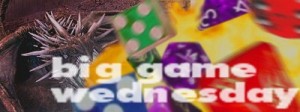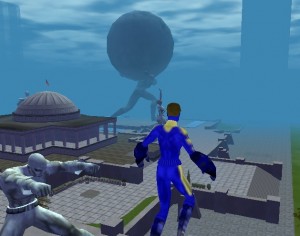
So yeah, the first big surprise in March is the return of Big Game Wednesday, although in honor of the transition to Hero Go Home, and for one other reason that will become clear in a couple of weeks, I’m going to concentrate on superhero computer gaming. And since the only real superhero games I’ve played on the computer are MMO’s, that’s what I’ll be concentrating on.
In 2004, a company called Cryptic Studios released the first superhero-based Massive Multiplayer Online Roleplaying Game, City of Heroes, through NC Soft. There had long been rumors that my favorite pen-and-paper roleplaying game, Champions, would release a computer game version, but it never came to fruition.
And really, given the limitations of computer game technology and storage media, there was no way for them to release the kind of freeform adventure in a truly convincing city of any scale that I would want to play. But City of Heroes, because of its on-line nature, came closer than I imagined they could.
One of the game’s coolest features was its character creation. You couldn’t create a character from scratch the way you could with Champions, but even Champions, with all its flexibility, realized after a while that guidelines for character creation could be helpful. So they created several archetypes that you could use for inspiration  (the Brick, the Energy Projector, the Mentalist, the Martial Artist) and gave you helpful tips on constructing the type you wanted to play.
City of Heroes took that idea further by creating specific powersets within each Archetype (which also conformed to the classic MMORPG roles). You would choose an Archetype (Blaster, Tank, Scrapper, Controller, Defender), and within that Archetype, you would pick a power subtype (Blasters could use Energy, Fire, Ice, or others, for example).
Once you’d chosen your powers, you would create a costume, one of the best features of the game. The costume creation system was very flexible and allowed you to get a wide variety of looks.
Once your character was created, you could play in basically two ways. You could be sent on missions by contacts you met within the game (either solo or on a team), or you could go to a PVP zone to battle other players. I always preferred playing solo as opposed to linking up with some random dudes for a few missions, but there were some missions you just couldn’t complete by yourself. They were designed for teams, and some you couldn’t even start without assembling a team first. Which sucked.
But I liked the way some missions linked together to form  story arcs; once you’d completed the story arc, you received extra rewards in the form of a power enhancement and a souvenir. Other accomplishments in the game would yield badges, which you could use to give yourself a title (for instance, my main character, Metatronic, spent a long time identified as “Metatronic, Superspy”).
The world of the game was gorgeous, another thing the game’s makers got just right. Paragon City was full of towering skyscrapers and looming statues and monuments, and it was especially fun just to fly around and sightsee.
One of my more juvenile pleasures in the game during a badge-hunting run was to fly up to the top of a particularly large statue honoring some female hero and literally stand on the shelf of her breasts. It was childish, but cool.
The graphics in these pics don’t really do the game justice. Number one, my graphics card was old, so I couldn’t run the game at its full resolution. And number two, screencaps don’t give you the pleasure of seeing the characters in motion.
Of course, the game wasn’t perfect. For instance, for a city with a million superheroes running around, there were a hell of a lot of muggers committing crimes in full daylight. Even worse, since you stopped getting experience points for them once you got a certain level higher than they were, you had a tendency to just run right past and leave the NPC’s to their fate.
And I didn’t like the way you had to wait and grind your way through 14 levels to finally get a decent movement power, or 20 levels to earn a cape. That kind of stuff seemed as silly and arbitrary as the mission designs which forced you to team up.
Also, although the heroes had a very comic-bookish feel, the enemies didn’t always. It got pretty boring sometimes grinding your way through the same generic street gangs all the time. Some of the villain groups were colorful and interesting (like the Tsoo or the Freakshow or the Sky Raiders), but most were bland and dull (the Outcasts, the Warriors, the Trolls).
My least favorite group was the Family, a generic Mafia clone. I burned out on the whole Mafia thing years ago (odd since I ended up writing Death Wave, in which the Mafia plays a huge part), so the charm of thugs in suits with names like “Johnny One-Eye” was lost on me. The heroes felt like comic book heroes and the world looked like a comic book world, but the villains you fought just didn’t feel like comic book villains.
Still, I enjoyed playing while I could afford to subscribe. I liked completing story arcs. I liked collecting badges and souvenirs and decorating my base once they released an update which allowed them. I liked designing power-up variations on my character’s costume and binding key macros so with one click, I could say a catch phrase and power-up into a different look.And I loved just flying free and exploring the city.
But at some point, fatigue and other time demands set in, and I stopped City of Heroes for a while. What brought me back was the fact that there was an entire game’s worth of new content that I could play with the same subscription price when Cryptic and NC Soft released a sequel.
City of Villains, next week.





